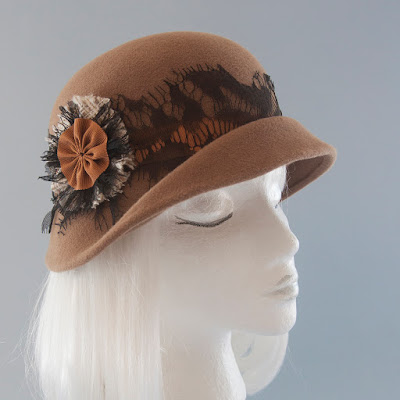If you're anything like I am, you were raised that Labor Day was just a day off. If you work (or go to school), here's an extra day off to reward you. Have a picnic! Shop some sales! Stop wearing white!
Today, I am working. Like many makers, I'm a one-woman show. I source my own supplies. I make everything by hand myself. I take the photos. I do my own bookkeeping and marketing. When someone buys one of my hats, I pack it up myself and take it to the post office. ... And I'm very lucky.
 |
| This handmade cloche will be shipping out tomorrow. |
Labor Day is an important day to the fashion industry. The origin and purpose of Labor Day is to acknowledge the achievements of the labor movement.
More than one hundred years ago, the Triangle Shirtwaist Factory Fire killed 146 people, mostly young women. Since then, the U.S. has instituted many reforms that make workplaces safer.
 |
| Union members demonstrating after the Triangle Shirtwaist fire. |
That's the good news. The bad news is that, in recent years, more and more fashion companies have moved their manufacturing out of the U.S. — and into countries with more lax regulations. Not only has this caused the sad decline of New York City's Garment District, but more significantly, it has resulted in tragedies such as the collapse of a garment factory complex in Bangladesh that killed more than 1,100 people in 2014. ... 2014!
What a lot of people don't realize is that all clothes are handmade.
Yep. That $15 pair of jeans wasn't made by a machine. They were made by a person sitting at a sewing machine and using their hands.
And avoiding clothing made by exploited workers is so hard. It's more expensive. It requires research. It requires time and effort and labor.
I'm guilty of it, too. I stay away from cheaply produced clothes that are churned out en masse and designed to last a season (or less) before they're replaced by the next trendy item. But I bought a new packet of underwear the other day and didn't look at where they were made. I checked just now. ... Bangladesh.
If I hadn't bought that underwear, I wouldn't be driving the company out of business. If a whole bunch of us boycott Forever 21, there will still be plenty of people buying their clothes. And nobody is going to trade buying a $20 dress from H&M for buying a handmade hat from me.
But instead of having a day off or a picnic this Labor Day, I am using it as a reminder to stop and think about where my clothing comes from.
Here's a great piece from The Atlantic about why it's good to invest more money in pieces of clothing.
Take a look around for "slow fashion." Sustainable or ethically produced clothing. Fair trade items. If it seems like the handmade piece you love is over-priced, it's not (necessarily) because it was made by a pretentious hipster in Brooklyn. It's because you're comparing it to the distorted, inappropriately low prices of "fast fashion."
Here are some neat resources:
- The Clean Clothes Campaign
- Fashion Revolution (#whomademyclothes)
- Slow Fashioned
